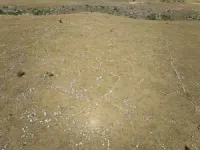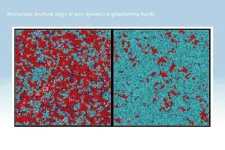(Press-News.org) A Cranfield University, UK, academic has used drone mapping to investigate a 3000-year-old ‘mega fortress’ in the Caucasus mountains. Dr Nathaniel Erb-Satullo, Senior Lecturer in Architectural Science at Cranfield Forensic Institute, has been researching the site since 2018 with Dimitri Jachvliani, his co-director from the Georgian National Museum, revealing details that re-shape our understanding of the site and contribute to a global reassessment of ancient settlement growth and urbanism.
Fortress settlements in the South Caucasus appeared between 1500-500 BCE, and represent an unprecedented development in the prehistory of the regions. Situated at the boundary between Europe, the Eurasian Steppe, and the Middle East, the Caucasus region has a long history as a cultural crossroads with distinctive local identities.
Research on the fortress – named Dmanisis Gora – began with test excavations on a fortified promontory between two deep gorges. A subsequent visit in Autumn, when the knee-high high summer grasses had died back, revealed that the site was much larger than originally thought. Scattered across a huge area outside the inner fortress were the remains of additional fortification walls and other stone structures. Because of its size, it was impossible to get a sense of the site as a whole from the ground.
“That was what sparked the idea of using a drone to assess the site from the air,” commented Dr Erb-Satullo. “The drone took nearly 11,000 pictures which were knitted together using advanced software to produce high-resolution digital elevation models and orthophotos – composite pictures that show every point as if you were looking straight down.
“These datasets enabled us to identify subtle topographic features and create accurate maps of all the fortification walls, graves, field systems, and other stone structures within the outer settlement. The results of this survey showed that the site was more than 40 times larger than originally thought, including a large outer settlement defended by a 1km long fortification wall.”
The research team used a DJI Phantom 4 RTK drone which can provide relative positional accuracy of under 2cm as well as extremely high-resolution aerial imagery. In order to obtain a highly accurate map of human-made features, the team carefully checked each feature in the aerial imagery to confirm its identification.
To understand how the landscape of the site had evolved, the orthophotos were compared with 50-year-old photos taken by a Cold War-era spy satellite declassified in 2013. That gave researchers much needed insight into which features were recent, which were older. It also enabled researchers to assess what areas of the ancient settlement were damaged by modern agriculture. All of those data sets were merged in Geographic Information System (GIS) software, helping to identify patterns and changes in the landscape.
“The use of drones has allowed us to understand the significance of the site and document it in a way that simply wouldn’t be possible on the ground” said Dr Erb-Satullo. ”Dmanisis Gora isn’t just a significant find for the Southern Caucasus region, but has a broader significance for the diversity in the structure of large scale settlements and their formation processes. We hypothesize that Dmanisis Gora expanded because of its interactions with mobile pastoral groups, and its large outer settlement may have expanded and contracted seasonally. With the site now extensively mapped, further study will start to provide insights into areas such as population density and intensity, livestock movements and agricultural practices, among others.”
This data will give researchers new insights into Late Bronze Age and Early Iron Age societies, and how these communities functioned. Since the aerial survey was completed, Dr. Erb-Satullo has been carrying out further excavations at the site, uncovering tens of thousands of pottery shards, animal bones, and other artefacts that tell us more about the society that built this fortress.
This work has been funded by the Gerda Henkel Foundation, the Gerald Averay Wainwright Fund and the British Institute at Ankara.
END
When the past meets the future: Innovative drone mapping unlocks secrets of Bronze Age ‘mega fortress’ in the Caucasus
2025-01-08
ELSE PRESS RELEASES FROM THIS DATE:
AI could improve the success of IVF treatment
2025-01-08
During IVF treatment, doctors use ultrasound scans to monitor the size of follicles - small sacs in the ovaries containing eggs - to decide when to give a hormone injection known as the ‘trigger’ to prepare the eggs for collection and ensure that they are ready to be fertilised with sperm to create embryos. The timing of the trigger is a key decision, as it works less effectively if the follicles are too small or too large at the time of administration. After the eggs are collected and fertilised by sperm, an embryo is then selected and implanted into the womb to hopefully lead to pregnancy.
Researchers used ‘Explainable ...
Moving in sync, slowly, in glassy liquids
2025-01-08
Tokyo, Japan – Glass might seem to be an ordinary material we encounter every day, but the physics at play inside are actually quite complex and still not completely understood by scientists. Some panes of glass, such as the stained-glass windows in many Medieval buildings, have remained rigid for centuries, as their constituent molecules are perpetually frozen in a state of disorder. Similarly, supercooled liquids are not quite solid, in the sense that their fundamental particles do not stick to a lattice ...
Climate change linked with worse HIV prevention and care
2025-01-08
Toronto, ON – New challenges in HIV prevention and care are emerging due to climate change, according to a review published earlier this month in Current Opinions in Infectious Disease.
Researchers from the University of Toronto analyzed 22 recent studies exploring HIV-related outcomes in the context of climate change and identified several links between extreme weather events and HIV prevention and care.
Climate change-related extreme weather events, such as drought and flooding, were associated with poorer HIV prevention outcomes, including ...
Exeter launches second round of global funding to tackle antifungal drug resistance
2025-01-08
A University of Exeter funding scheme designed to combat the global challenge of fungal antimicrobial resistance (fAMR) has announced a new call for applications.
The FAILSAFE project (Fungal AMR Innovations for LMICS: Solutions and Access For Everyone) is a groundbreaking initiative tackling antifungal drug resistance. The project aims to promote worldwide innovations to tackle the global health threat of fungal infections in humans, plants and animals increasingly growing resistant to available treatment.
Already, the FAILSAFE project has awarded more than £1.7 million in grants ...
Harnessing AI to respond to the global threat of antimicrobial resistance
2025-01-08
AMR is when microorganisms that cause infections, such as bacteria and viruses, change over time and no longer respond to antibiotic medicines.
It makes serious conditions such as HIV, tuberculosis and malaria more difficult to treat and increases the risk of severe illness, disease spread and death.
AMR particularly impacts low-to-middle-income countries where water quality is often poor and the spread environmental spread of AMR via wastes can be high.
In 2015 the World Health Organization (WHO) formulated a Global Action Plan to co-ordinate efforts to tackle AMR.
As a result, 194 WHO member states committed to developing country-specific ...
New findings may help researchers develop a grapefruit devoid of compounds that affect medication levels
2025-01-08
Grapefruit and pummelo contain compounds called furanocoumarins that may affect the blood levels of more than 100 prescription drugs, so that people taking these medications are advised to remove these fruits from their diets. Research published in New Phytologist reveals genetic information about the synthesis of furanocoumarins in different citrus plant tissues and species and provides new insights that could be used to develop grapefruit and pummelo that lack furanocoumarins.
The research indicates that the production of furanocoumarins in citrus ...
Advanced wearable robot eases heavy lifting and other injury-causing tasks for workers
2025-01-08
In research published in Advanced Intelligence Systems, scientists have developed an innovative, soft, wearable robot to help workers avoid job-related injuries while lifting, lowering, and carrying objects.
While many available wearable robots are limited to supporting a single degree of freedom of the body (meaning the body can only move in one direction at a given joint), the new robot, called WeaRo, operates through multiple degrees of freedom, allowing for complex movements.
In tests, WeaRo effectively reduced the muscle activation levels of lumbar, biceps, and triceps muscles by a maximum of 18.2%, 29.1%, and ...
Does job strain compromise long-term sleep quality?
2025-01-08
In a recent study published in the American Journal of Industrial Medicine, middle aged workers in the U.S. who reported high job strain at the start of the study experienced significantly more sleep disturbances over an average follow-up of nine years.
The study analyzed data from 1,721 workers, with an average age of 51 years, who participated in the Midlife in the United States (MIDUS) study. Sleep disturbances were assessed with an established scale, based on four sleep-related symptoms: trouble falling asleep, waking up during ...
Artificial intelligence–based method assesses depression in business leaders
2025-01-08
Researchers have developed a novel method to assess depression in CEOs by using machine learning models (a type of artificial intelligence) to analyze vocal acoustic features from conference call recordings. This innovative approach, detailed in an article published in the Journal of Accounting Research, provides insights into a mental health issue that often remains hidden in high-pressure executive roles.
The researchers examined how CEO depression is related to career outcomes, compensation, and incentives. Their findings suggest ...
Study assesses the benefits of alfalfa-almond intercropping
2025-01-08
The practice of growing different but complementary plants within a given area, also known as intercropping, has numerous positive effects such as reduced soil erosion, weed suppression, nitrogen fixation (the conversion of atmospheric nitrogen to nitrogen compounds that can be used by plants and other organisms), and pollinator benefits. New research published in Agrosystems, Geosciences & Environment reveals the increased land use efficiency and environmental benefits in an alfalfa–almond intercropped ecosystem ...



